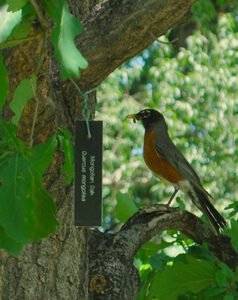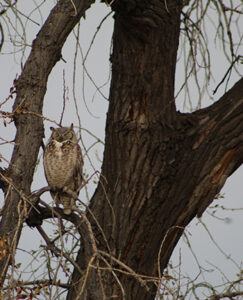Forests and Feathered Friends Right Outside Your Colorado Home
Whether you live in the mountains or the foothills or even the plains, you’ve likely heard the chirps of countless backyard birds from your Colorado home. Birds of all shapes and sizes flutter from branch to branch in the trees right outside your windows.
There are more than 520 bird species in Colorado, and many of these live and interact with urban forests. Trees in urban forests provide homes, meals and perches for birds. In return, birds often pollinate flowers and remove pests from trees.
In honor of National Great Outdoors Month (June of every year), we’re sharing simple ways to get outside. Birding is often assumed to be a wilderness activity, but you can do it in your favorite urban spaces, too!
Review these common birds, their key identifiable traits, and how they interact with trees, to be able to identify them next time you’re in a Colorado city.

Black-billed magpies are black with white bellies and wing tips and blue iridescence down their backs and tails.
Black-billed magpies use sticks and grass to build big nests in tree canopies and shrubs among other places. They often roost together and use plant cover to protect themselves from raptors.
Photo: Don Morda, Curecanti National Recreation Area, Colorado. Audio: J. Job, Rocky Mountain National Park, Colo.
American robins have gray-brown bodies, burnt orange chests, dark gray heads and white patches on the underside of their tails.
American robins forage for fruits from a variety of trees and shrubs. They often nest in the lower branches of trees in the warmer seasons and roost in groups in cooler seasons.
Photo: Morgan Murphy, Fort Collins, Colo. Audio: Jennifer Jerret, NPS and MSU Acoustic Atlas
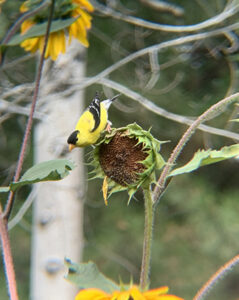
American goldfinches are a brilliant shade of yellow with black wings, black patches atop their heads, and white patches on the underside of their wings and tails.
American goldfinches eat seeds from a variety of deciduous trees and composite plants. They spend much of their time in open woodlands and nest in the branches of woody plants in these ecosystems.
Photo: Julie Gunning, Louisville, Colo. Audio: Andrew Spencer, Dinosaur National Monument, Colo.
Great horned owls are large birds with spotted brown bodies, round faces, yellow eyes, and two distinctive tufts on their heads resembling horns.
Great horned owls are predatory birds that eat just about every type of animal, most commonly mammals and other birds. They use trees as perches to spot prey while hunting and they roost in trees to rest after hunting. During breeding season, they either occupy nests made by other birds or use tree materials to build nests in cavities and crotches.
Photo: Melanie Matthews, Thornton, Colo. Audio: Ted Floyd, Lafayette, Colo.
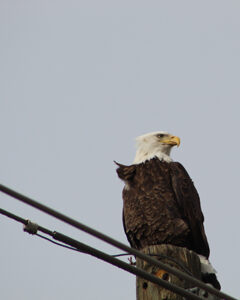
Bald eagles are large birds with dark brown bodies, white heads and tails, and curved yellow bills.
Bald eagles often perch on the tallest trees near bodies of water where they can spot fish, birds and other prey. They use sticks and soft plant material to build their nests, which are often at the tops of tall conifers.
Photo: Melanie Matthews, Lakewood, Colo. Audio: Jennifer Jerret, NPS and MSU Acoustic Atlas.
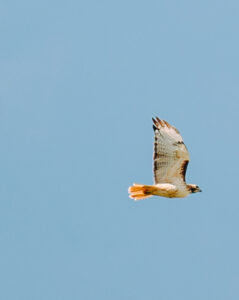
Red-tailed hawks are large, brown-bodied birds with white and light brown undersides and burnt orange tails.
Red-tailed hawks commonly perch along fields and roads and soar above open areas in search of mammals, birds and other prey. They use bark and foliage to build their nests at the tops of tall trees that allow them to survey the land around them.
Photo: Field Peterson, CSU Foothills Campus. Audio: Andrew Spencer, Duck Creek State Wildlife Area, Colo.
How to Get Started Birding
Find these birds by looking right outside your window or by travelling to the nearest natural area in your city.
Here are some tips you might consider before getting started:
- Patience is key. You’re not guaranteed to see lots of birds every time, but your chances go up the more often you look and the longer you wait.
- Birds often change their songs and behaviors throughout the year. Do your research on what they’ll sound like and where you might find them at a certain time of year in your area. The Merlin mobile app is a helpful resource that identifies birds by their calls, physical characteristics, and behaviors.
- Birds can be hard to spot when they’re hidden in thick tree canopies. You may find it helpful to listen first and then watch for movement. If you can get your hands on a pair, binoculars are also useful.
To delve deeper into the birding world, take these next steps:
- Consider setting up a bird feeder around your home to attract hummingbirds and seedeaters.
- Explore tips and tricks from these Colorado Field Ornithologists and Bird Conservatory of the Rockies resources.
- Take part in an Audubon Christmas Bird Count or join bird groups and birding events in your city to practice your identification skills with others.
Happy Birding!
Author:
Morgan Murphy, 2024 Communications & Communities Intern, Colorado State Forest Service


